| |

1916
LAND WAR IN
THE AGE OF MACHINES: 1914-1918
| Combat
Situations |
|
Infantry Assaults
A typical
frontal assault by infantry can be easily achieved by moving an infantry unit
toward enemy bases until base to base contact is achieved between any two
portions of the enemy units. There are however, many variations on this theme,
some of which are valid maneuvers and some of which are not allowed for game
play. Below are a few examples to give new players a feel for how units are
moved into contact with each other. |
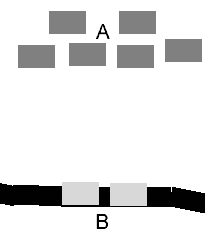
Figure 1. |
 Figure 1
shows two units, the defending unit B is a two base "remnant" occupying a
section of trenchline shown in black. The attacking unit A is a six base "weak"
unit depicted by the grey squares at the top of the figure. Both units are
assumed to be facing each other. Figure 1
shows two units, the defending unit B is a two base "remnant" occupying a
section of trenchline shown in black. The attacking unit A is a six base "weak"
unit depicted by the grey squares at the top of the figure. Both units are
assumed to be facing each other.
 Figure 2 shows a flanking assault. Unit A
has used its movement to establish base to base contact and to throw its two
"wing" bases around the defenders flank in order to gain an advantage during
the assault rolls. However, with the newly expanded definition for the
packed target small arms modifier now in effect, players attempting such
maneuvers from too great of a distance will discover that the flanking bases
create a packed target as they squeeze in to contact the defender's flanks (as
shown at right). Only if the attacking unit begins its movement close enough to
the target of the assault will it usually have enough movement available to
maneuver onto the flanks of the defender while still maintaining a loose
formation. Figure 2 shows a flanking assault. Unit A
has used its movement to establish base to base contact and to throw its two
"wing" bases around the defenders flank in order to gain an advantage during
the assault rolls. However, with the newly expanded definition for the
packed target small arms modifier now in effect, players attempting such
maneuvers from too great of a distance will discover that the flanking bases
create a packed target as they squeeze in to contact the defender's flanks (as
shown at right). Only if the attacking unit begins its movement close enough to
the target of the assault will it usually have enough movement available to
maneuver onto the flanks of the defender while still maintaining a loose
formation.
|
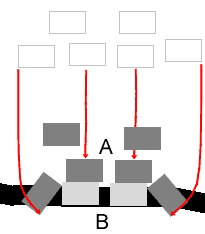
Figure 2. |
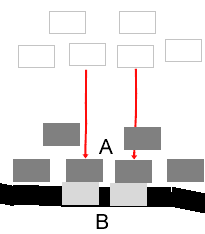
Figure 3. |
 Figure 3.
The example at left shows a more typical frontal assault which loses the
benefit of a flanking attack while avoiding the potential extra loss as a
packed target. Figure 3.
The example at left shows a more typical frontal assault which loses the
benefit of a flanking attack while avoiding the potential extra loss as a
packed target.
 Figure 4. This figure gives an example of an illegal
assault move called "Daisy Chaining." This is sometimes attempted when a player
maneuvers a unit into a well covered position near an enemy unit. If allowed,
the assaulting player retains benefit of the cover while simultaneously
conducting the assault. In this example, the attacking unit B has moved two of
its bases forward while keeping both within the allowed base interval. Only one
base is put into assault contact with the defending unit A, while most of the
remainder cower in the woods. This is not a legal game action. Any unit
committed to moving into assault contact with an enemy must move all of its
bases forward and attempt to make direct contact, although the unit may still
retain an open formation in the process (i.e. - it is not obliged to form a
packed formation). Figure 4. This figure gives an example of an illegal
assault move called "Daisy Chaining." This is sometimes attempted when a player
maneuvers a unit into a well covered position near an enemy unit. If allowed,
the assaulting player retains benefit of the cover while simultaneously
conducting the assault. In this example, the attacking unit B has moved two of
its bases forward while keeping both within the allowed base interval. Only one
base is put into assault contact with the defending unit A, while most of the
remainder cower in the woods. This is not a legal game action. Any unit
committed to moving into assault contact with an enemy must move all of its
bases forward and attempt to make direct contact, although the unit may still
retain an open formation in the process (i.e. - it is not obliged to form a
packed formation).
|
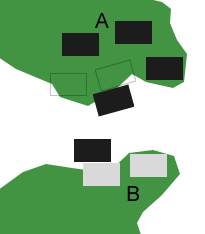
Figure 4. |
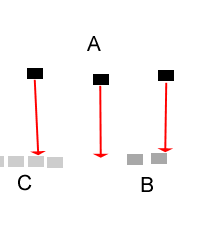
Figure 5. |
 This set of
examples shows an attacking unit (A) which is spread out toward the limit of
its base interval allowance. Its assault options are many, but some of the more
obvious include Figure 5 at left, which shows a general advance to contact with
both the remnant unit B, and the right flank of a much larger unit C. The
center base of unit A might be tempted to try a flanking maneuver on one of the
defenders, but it would likely violate the base interval and so it remains in a
"bridging" position. Unless it rolls well, unit A is not likely to
succeed. This set of
examples shows an attacking unit (A) which is spread out toward the limit of
its base interval allowance. Its assault options are many, but some of the more
obvious include Figure 5 at left, which shows a general advance to contact with
both the remnant unit B, and the right flank of a much larger unit C. The
center base of unit A might be tempted to try a flanking maneuver on one of the
defenders, but it would likely violate the base interval and so it remains in a
"bridging" position. Unless it rolls well, unit A is not likely to
succeed.
 Figure 6. In this figure, unit A has inclined its assault to the
left, bringing its weight to bear on the isolated unit B. Since there is no
base to base contact with unit C, it will not be involved in the assault unless
it moves forward to contact unit A during its own movement. Note that in this
example, the right-flank base of unit A might be able (if it has the extra
movement) to flank unit B by moving into contact with the left side of unit B's
left-most base. Figure 6. In this figure, unit A has inclined its assault to the
left, bringing its weight to bear on the isolated unit B. Since there is no
base to base contact with unit C, it will not be involved in the assault unless
it moves forward to contact unit A during its own movement. Note that in this
example, the right-flank base of unit A might be able (if it has the extra
movement) to flank unit B by moving into contact with the left side of unit B's
left-most base. |
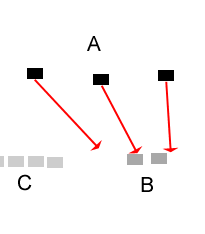
Figure 6. |
Trench Fighting
Many of the
standard methods of movement and assault do not translate well when the units
and bases involved are forced to operate within the confines of trenches. The
guidelines below offer a few standard methods of movement and interpretation
which will allow player to re-create the difficulties of maneuvering in the
trenches. |
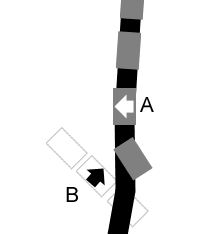
Figure 1. |
 Refusing
the Flank: The figure at left shows a unit (A) which has inclined its left
flank base in order to prevent a flanking assault from any units which might
sweep into that section of trenches. Note that the end base is still considered
to be within the trenches even though a portion of it is outside the trench
marker. Refusing
the Flank: The figure at left shows a unit (A) which has inclined its left
flank base in order to prevent a flanking assault from any units which might
sweep into that section of trenches. Note that the end base is still considered
to be within the trenches even though a portion of it is outside the trench
marker.
 Transverse Movement: Units must face the direction in which
they assault, even in trenches. The same facing practice is also advisable for
units conducting extensive regular movement when there are enemy units present
within a trench system. For units to face down the length of the trench during
such movement, place them in an open column arrangement as shown with unit B at
right. Transverse Movement: Units must face the direction in which
they assault, even in trenches. The same facing practice is also advisable for
units conducting extensive regular movement when there are enemy units present
within a trench system. For units to face down the length of the trench during
such movement, place them in an open column arrangement as shown with unit B at
right.
|
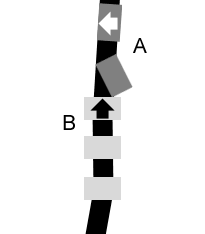
Figure 2. |
|

